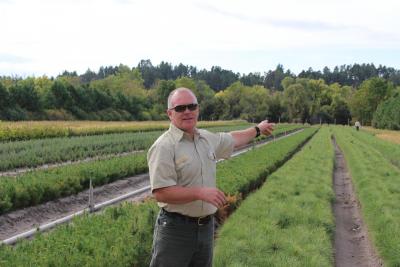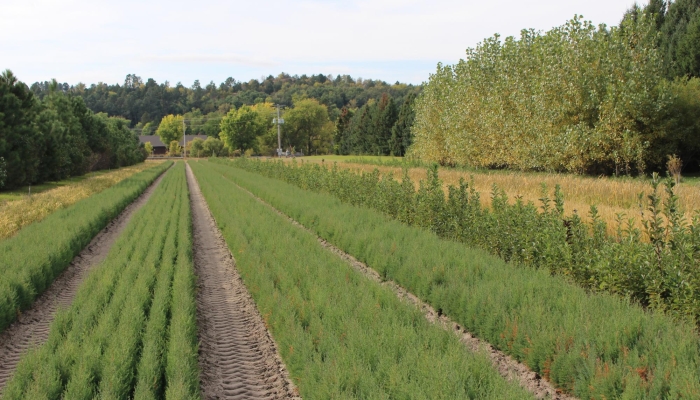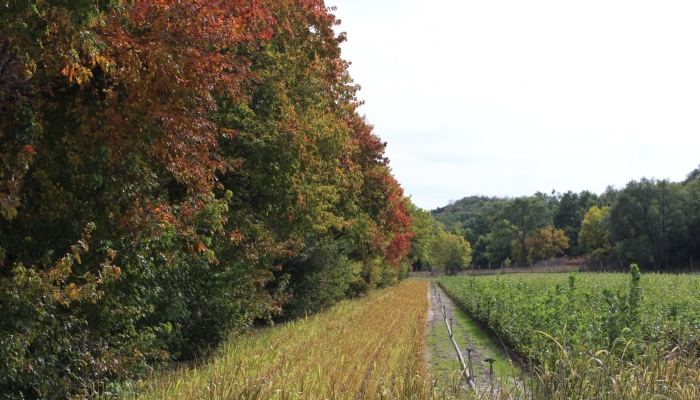A Visit to Bessey Nursery
By Chrystal Houston, Public Relations Manager, Upper Big Blue NRD
"Who knew Nebraska had so many trees?” I thought when we arrived in Halsey, Nebraska, home of the Charles E. Bessey Nursery. Thousands of mature trees surround the property, their green, leafy majesty so unexpected in the plains—a desert oasis, a verdant outcropping of about 20,000 acres of trees in the surrounding sandhills. The nursery sits on the edge of a 91,000-acre section of Nebraska National Forest and Grasslands. It’s a man-made forest, the seedlings for which have been grown at the Bessy Nursery since 1902.
Most of the seedlings for the Upper Big Blue Natural Resources District Conservation Tree Program are also grown here, which is why I’m touring the facility on this glorious autumn day. The nursery annually produces 1.5 million bare root seedlings, which are shipped across the state and region for planting. There’s a wide variety of trees produced, from fir to fruit. Some of the species are familiar, such as Silver Maple and Colorado Blue Spruce, while others are new to me. (Ever heard of a Buffaloberry or Skunkbush Sumac?)
 The tour begins with a planting demonstration. A forester steers a John Deere down a bed of slightly raised sand the length of a football field. Another forester rides on a planting apparatus pulled behind, feeding seeds through a hopper. Six rows of seeds are deposited into the sand on each pass and tucked in with protective plastic sheeting. The trees will be harvested when they are still fairly small, so they are able to be planted close together. Sand, as it turns out, is an ideal medium for a nursery operation. The tiny trees can grow quickly if properly irrigated. When it’s time to harvest them, a gentle tug is all that’s required to pull them up with their roots perfectly clean and fully intact—ready to ship and replant. The operation is fed by the Ogallala Aquifer, the vast underwater reservoir that sits a few hundred feet below the surface.
The tour begins with a planting demonstration. A forester steers a John Deere down a bed of slightly raised sand the length of a football field. Another forester rides on a planting apparatus pulled behind, feeding seeds through a hopper. Six rows of seeds are deposited into the sand on each pass and tucked in with protective plastic sheeting. The trees will be harvested when they are still fairly small, so they are able to be planted close together. Sand, as it turns out, is an ideal medium for a nursery operation. The tiny trees can grow quickly if properly irrigated. When it’s time to harvest them, a gentle tug is all that’s required to pull them up with their roots perfectly clean and fully intact—ready to ship and replant. The operation is fed by the Ogallala Aquifer, the vast underwater reservoir that sits a few hundred feet below the surface.
Next to this freshly planted field sits a row of greenhouses filled with hundreds of thousands of pine, spruce, and Douglas Fir trees in containers. I’m a giant as I walk through the center aisle of a greenhouse full of baby fir trees, my hand brushing along the treetops of a miniature forest. In addition to the bare root conifer and hardwood seedlings produced here each year, the nursery also grows 750,000-850,000 container trees like these.
 The tour continues to other nursery fields (the facility has 46 acres of irrigated seed beds), where row upon row of trees are growing in perfectly ordered lines. Richard Gilbert, manager of Bessey Nursery, displays the current stock with pride, showing off the many varieties produced and elaborating on the characteristics of each, pointing out the trees that have the best fall colors or the tastiest fruit and which are most heat- or drought-tolerant.
The tour continues to other nursery fields (the facility has 46 acres of irrigated seed beds), where row upon row of trees are growing in perfectly ordered lines. Richard Gilbert, manager of Bessey Nursery, displays the current stock with pride, showing off the many varieties produced and elaborating on the characteristics of each, pointing out the trees that have the best fall colors or the tastiest fruit and which are most heat- or drought-tolerant.
One of the most significant components of Bessey Nursery is not on our tour today. In a nearby building is a large walk-in freezer filled with labeled boxes. There, about 14,000 pounds of tree seeds are kept as a buffer against natural disasters such as fire and blight. This seed bank represents a secure future for Nebraska and the region, as Gilbert and his crew could use it to repopulate forests after catastrophic loss.
Planting trees is a hopeful activity, an investment in our collective future. I return from Bessey Nursery with a few small trees of my own—a maple for my front yard, elderberry and chokeberry for the back. I’ve lived in my house for years, yet putting these trees in the ground is the first time the place really feels like my home—a place where I intend to be, and to invest in, for years to come.


